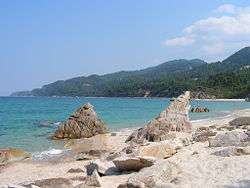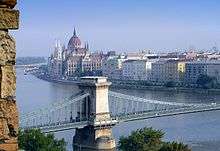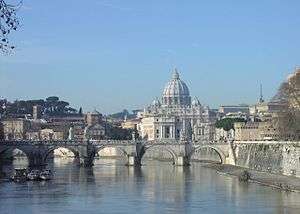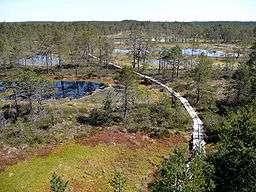Geography of the European Union
 Topographic map of the European Union | |
 | |
| Continent | Predominately Europe, with territories elsewhere |
|---|---|
| Area | Ranked 7th |
| • Total | 4,422,773 km2 (1,707,642 sq mi) |
| • Land | 96.92% |
| • Water | 3.08% |
| Coastline | 65,993 km (41,006 mi) |
| Borders |
Total land borders: 13,454 km Albania 282 km, Andorra 120.3 km, Belarus 1,050 km, Bosnia and Herzegovina 932 km, Brazil 673 km, Liechtenstein 34.9 km, Macedonia 394 km, Moldova 450 km, Monaco 4.4 km, Montenegro 23 km, Morocco 16 km, Norway 2,348 km, Russia 2,257 km, San Marino 39 km, Serbia 1,263 km, Suriname 510 km, Switzerland 1,811 km, Turkey 446 km, Ukraine 1,257 km, Vatican City 3.2 km |
| Highest point |
Mont Blanc 4,810.45 m |
| Lowest point |
Lammefjord, Zuidplaspolder -7 m |
| Longest river |
Danube 2,860 km |
| Largest lake |
Vänern 5,650 km2 |
The geography of the European Union describes the geographic features of the European Union (EU), a multinational polity that occupies a large portion of Europe and covers 4,422,773 km2 (1,707,642 sq mi).[1] Its European territory extends northeast to Finland, northwest to Ireland, southeast to Cyprus (an island that is physiographically part of Asia) and southwest to Iberia. Additionally, the EU includes numerous islands around the world, and French Guiana in South America.
Collectively, it represents the seventh largest territory in the world by area. Including all overseas territories, the EU shares borders with 20 countries.
Geography by member states
The European Union has 28 member states and 6 candidates. See the geography of each state:
Physical geography
Most of the European Union is on the European continent. The EU covers less than half of the territory of Europe, significant parts of the continent especially in the East (e.g. European Russia, Ukraine, Belarus) and smaller parts in the North and Center are not part of the EU. The member states of the EU have land borders with 19 other nations.
It is estimated that the coastline of the European Union is 66,000 km long,[3] bordering the Atlantic Ocean, Mediterranean Sea, Black Sea and Baltic Sea. European mountain ranges include the Alps, Carpathian Mountains, Balkan Mountains and Scandinavian Mountains with the tallest mountain in the Union being Mont Blanc.
Several overseas territories and dependencies of various member states are also formally part of the EU (for Spain: the Canary Islands, Ceuta and Melilla; for Portugal: the Azores, Madeira; for UK: Gibraltar and British sovereign bases in Cyprus; for France: La Réunion, French Guiana, Martinique, Guadeloupe, Saint-Martin and Saint-Barthélemy) while in other cases territories associated with member states are not part of the EU (e.g. Greenland, the Faroe Islands, most territories associated to the United Kingdom, Aruba, the Netherlands Antilles, Mayotte, French Polynesia, Wallis and Futuna, or New Caledonia).
Including overseas territories of member states, the EU includes most types of climate from Arctic to tropical. Meteorological averages for the EU as a whole are therefore not meaningful. The majority of the population live in areas with a Mediterranean climate (southern Europe), a temperate maritime climate (western Europe), or a warm summer continental or hemiboreal climate (in eastern member states).
Geology

Europe's most significant feature is the dichotomy between highland and mountainous Southern Europe and a vast, partially underwater, northern plain ranging from United Kingdom in the west to Poland in the east. These two halves are separated by the mountain chains of Pyrenees and Alps/Carpathians. The northern plains are delimited in the west by the Scandinavian mountains and the mountainous parts of the British Isles. Major shallow water bodies submerging parts of the northern plains are the Celtic Sea, the North Sea, the Baltic Sea complex, and the Barents Sea.
The northern plain contains the old geological continent of Baltica, and so may be regarded as the "main continent", while peripheral highlands and mountainous regions in south and west constitute fragments from various other geological continents.
The geology of Europe is hugely varied and complex, and gives rise to the wide variety of landscapes found across the continent, from the Scottish Highlands to the rolling plains of Hungary.
Climate

The climate of the European Union is of a temperate, continental nature, with a maritime climate prevailing on the western coasts and a mediterranean climate in the south. The climate is strongly conditioned by the Gulf Stream, which warms the western region to levels unattainable at similar latitudes on other continents. Western Europe is oceanic, while eastern Europe is continental and dry. Four seasons occur in western Europe, while southern Europe experiences a wet season and a dry season. Southern Europe is hot and dry during the summer months. The heaviest precipitation occurs downwind of water bodies due to the prevailing westerlies, with higher amounts also seen in the Alps. Tornadoes occur within Europe, but tend to be weak. The Netherlands and United Kingdom experience a disproportionately high number of tornadic events.
Mildest climate within the European Union occurs in Portuguese island of Madeira, where the average temperature varies from 19 °C (66 °F) during the day and 13 °C (55 °F) at night in winter to 26 °C (79 °F) during the day and 19 °C (66 °F) at night in summer. Also, mildest climate occurs in the Spanish island of Gran Canaria (Canary Islands), with average temperature varies from 21 °C (70 °F) during the day and 15 °C (59 °F) at night in winter to 27 °C (81 °F) during the day and 22 °C (72 °F) at night in summer. Both these islands lie in the Atlantic. As for the land on the European continent, mildest climate occurs in northwest part of Iberian Peninsula (also Spain and Portugal), between Bilbao, A Coruña and Porto. In this the coastal strand, the average temperature varies from 10–14 °C (50–57 °F) during the day and about 5 °C (41 °F) at night in January to 22–26 °C (72–79 °F) during the day and 15–16 °C (59–61 °F) at night in the middle of summer.
Rivers

The following are the longest rivers in the EU alongside their approximate lengths:[4][5]
Human geography
Demographics
The most populous member state is Germany, with an estimated 82.1 million people, and the least populous member state is Malta with 0.4 million. Birth rates in the EU are low with the average woman having 1.6 children. The highest birth-rates are found in the Republic of Ireland with 16.876 births per thousand people per year and France with 13.013 births per thousand people per year. Germany has the lowest birth rate in Europe with 8.221 births per thousand people per year.
| Member State | Population | Percent of total EU pop. | Land area km2 | Percent of total EU land area | Pop. density People/km2 |
|---|---|---|---|---|---|
| 507,416,607 | 100.00% | 4,324,782 | 100.00 | 116.0 | |
| 8,507,786 | 1.68% | 83,858 | 1.9 | 99.7 | |
| 11,203,992 | 2.21% | 30,510 | 0.7 | 352.0 | |
| 7,245,677 | 1.43% | 110,912 | 2.5 | 68.5 | |
| 4,246,700 | 0.84% | 56,594 | 1.3 | 75.8 | |
| 858,000 | 0.17% | 9,250 | 0.2 | 86.6 | |
| 10,512,419 | 2.07% | 78,866 | 1.8 | 132.8 | |
| 5,627,235 | 1.11% | 43,094 | 1.0 | 128.1 | |
| 1,315,819 | 0.26% | 45,226 | 1.0 | 29.6 | |
| 5,451,270 | 1.07% | 337,030 | 7.6 | 15.8 | |
| 65,856,609 | 12.98% | 643,548 | 14.6 | 99.6 | |
| 80,780,000 | 15.92% | 357,021 | 8.1 | 229.9 | |
| 10,992,589 | 2.17% | 131,957 | 3.0 | 85.4 | |
| 9,879,000 | 1.95% | 93,030 | 2.1 | 107.8 | |
| 4,604,029 | 0.91% | 70,280 | 1.6 | 64.3 | |
| 60,782,668 | 11.98% | 301,320 | 6.8 | 200.4 | |
| 2,001,468 | 0.39% | 64,589 | 1.5 | 35.0 | |
| 2,943,472 | 0.58% | 65,200 | 1.5 | 51.4 | |
| 549,680 | 0.11% | 2,586 | 0.1 | 190.1 | |
| 425,384 | 0.08% | 316 | 0.0 | 1,305.7 | |
| 16,829,289 | 3.32% | 41,526 | 0.9 | 396.9 | |
| 38,495,659 | 7.59% | 312,685 | 7.1 | 121.9 | |
| 10,427,301 | 2.05% | 92,931 | 2.1 | 114.4 | |
| 19,942,642 | 3.93% | 238,391 | 5.4 | 90.2 | |
| 5,415,949 | 1.07% | 48,845 | 1.1 | 110.8 | |
| 2,061,085 | 0.41% | 20,253 | 0.5 | 101.4 | |
| 46,507,760 | 9.17% | 504,782 | 11.4 | 93.4 | |
| 9,644,864 | 1.90% | 449,964 | 10.2 | 20.6 | |
| 64,308,261 | 12.67% | 244,820 | 5.5 | 251.7 |
Largest cities
The European Union is home to more global cities than any other region in the world. Over 16 cities with populations over one million inhabitants, counted in its city proper. Densely populated regions that have no single core but have emerged from the connection of several cites and are now encompassing large metropolitan areas are Rhine-Ruhr having approximately 11.5 million inhabitants (Cologne, Düsseldorf, et al.), Randstad approx. 7 million (Amsterdam, Rotterdam, The Hague et al.), the Flemish Diamond approx. 5.5 million, Frankfurt/Rhine-Main approx. 4 million (Frankfurt, Wiesbaden et al.) and the Upper Silesian Industry Area approx. 3.5 million. (Katowice, Sosnowiec et al.).[8]
 London |
||
 Rome |
 Paris |
| City proper | Population City limits in millions |
Density per km2 |
Urban area | Population Urban area in millions |
Metro area | Population Metro area in millions |
|---|---|---|---|---|---|---|
| London, UK | 7.5 | 4,761 | Paris, France | 10.1 | London, UK | 12–14 |
| Berlin, Germany | 3.4 | 3,815 | London, UK | 8.5 | Paris, France | 11.7 |
| Madrid, Spain | 3.1 | 1,985 | Madrid, Spain | 5.5 | Rhine-Ruhr, Germany | 10.2 |
| Rome, Italy | 2.7 | 5,198 | Ruhr, Germany | 5.3 | Randstad, Netherlands | 7.0 |
| Paris, France | 2.2 | 24,672 | Barcelona, Spain | 4.5 | Madrid, Spain | 5.8 |
| Bucharest, Romania | 1.9 | 9,131 | Milan, Italy | 3.8 | Barcelona, Spain | 5.3 |
| Hamburg, Germany | 1.8 | 2,310 | Berlin, Germany | 3.7 | Milan, Italy | 4.3 |
| Warsaw, Poland | 1.7 | 3,258 | Rotterdam–The Hague, Netherlands | 3.3 | Berlin, Germany | 4.3 |
| Budapest, Hungary | 1,7 | 3,570 | Athens, Greece | 3.2 | Frankfurt Rhine-Main, Germany | 4.1 |
| Vienna, Austria | 1.7 | 3,931 | Naples, Italy | 2.9 | Athens, Greece | 3.9 |
Environment

In 1957, when the EU was founded, it had no environmental policy, no environmental bureaucracy, and no environmental laws.[9] Today, the EU has some of the most progressive environmental policies of any state in the world. The environmental policy of the EU has therefore developed in remarkable fashion in the past four decades. An increasingly dense network of legislation has emerged, which now extends to all areas of environmental protection, including: air pollution control, water protection, waste management, nature conservation, and the control of chemicals, biotechnology and other industrial risks.[10] The Institute for European Environmental Policy estimates the body of EU environmental law amounts to well over 500 Directives, Regulations and Decisions.[11] Environmental policy has thus become a core area of European politics.
Such dynamic developments are surprising in light of the legal and institutional conditions which existed in the late 1950s and 60s.[12] Acting without any legislative authority, European policy-makers initially increased the EU's capacity to act by defining environmental policy as a trade problem. The most important reason for the introduction of a common environmental policy was the fear that trade barriers and competitive distortions in the Common Market could emerge due to the different environmental standards.[13] However, in the course of time, EU environmental policy emerged as a formal policy area, with its own policy actors, policy principles and procedures. The legal basis of EU environmental policy was not more explicitly established until the introduction of the Single European Act in 1987.[11]
Initially, EU environmental policy was rather introspective. More recently, however, the Union has demonstrated a growing leadership in global environmental governance. The role of the EU in securing the ratification and entry into force of the Kyoto Protocol in the face of US opposition is an example in this regard. This international dimension is reflected in the EU's Sixth Environmental Action Programme, which recognises that its strategic objectives can only be achieved if a series of key international environmental agreements are actively supported and properly implemented both at an EU level and worldwide. The entry into force of the Lisbon Treaty further strengthens the EU's global environmental leadership ambitions.[14] The vast body of EU environmental law which now exists has played a vital role in improving habitat and species protection in Europe as well as contributed to improvements in air and water quality and waste management.[11] However, significant challenges remain, both to meet existing EU targets and aspirations and to agree new targets and actions that will further improve the environment and the quality of life in Europe and beyond.
One of the top priorities of EU environmental policy is combatting climate change. In 2007, member states agreed that the EU is to use 20% renewable energy in the future and that it has to reduce carbon dioxide emissions in 2020 by at least 20% compared to 1990 levels.[15] This includes measures that in 2020, 10% of the overall fuel quantity used by cars and trucks in EU 27 should be running on renewable energy such as biofuels. This is considered to be one of the most ambitious moves of an important industrialised region to fight climate change.[16] The EU recently adopted an emissions trading system to incorporate carbon emissions into the economy.[17]
The European Green Capital is an annual award that is given to cities that focuses on the environment, energy efficiency and quality of life in urban areas to create smart city.
See also
References
- ↑ Figure including the four French overseas departments (French Guiana, Guadeloupe, Martinique, Réunion) which are an integral part of the European Union, but excluding the French overseas collectivities and territories, which are not part of the European Union.
- ↑ Following the referendum held on 23 June 2016, the United Kingdom voted with a majority in favour leaving the European Union. Legally, the referendum was advisory rather than binding, and the formal process for leaving has yet to be initiated.
- ↑ European Union CIA World Factbook
- ↑ European Rivers – Rivers of Europe, Map of Rivers in Europe, Major Rivers in Europe - Worldatlas.com
- ↑ River Systems of the World
- ↑ http://epp.eurostat.ec.europa.eu/tgm/table.do?tab=table&language=en&pcode=tps00001&tableSelection=1&footnotes=yes&labeling=labels&plugin=1
- ↑ Figures for France include the four overseas departments (French Guiana, Guadeloupe, Martinique, Réunion) which are integral parts of the European Union, but do not include the overseas collectivities and territories, which (but Saint Barthélemy and Saint Martin) are not part of the European Union.
- ↑ Indicators for larger urban zones 1999 – 2003, Eurostat. Accessed 25 January 2007
- ↑ Jordan, A.J. and Adelle, C. (eds)(2012) Environmental Policy in the European Union: Contexts, Actors and Policy Dynamics (3e). Earthscan: London and Sterling, VA.
- ↑ Knill, C. and Liefferink, D.(2012) The establishment of EU environmental policy, In: Jordan, A.J. and Adelle, C. (eds) Environmental Policy in the European Union: Contexts, Actors and Policy Dynamics (3e). Earthscan: London and Sterling, VA.
- 1 2 3 Institute for European Environmental Policy (2012) Manual of European Environmental Policy, Earthscan, London.
- ↑ Knill, C. and Liefferink, D.(2012) The etsbalishment of EU environmental policy, In: Jordan, A.J. and Adelle, C. (eds) Environmental Policy in the European Union: Contexts, Actors and Policy Dynamics (3e). Earthscan: London and Sterling, VA.
- ↑ Johnson, S.P. and Corcelle, G. (1989) The Environmental Policy of the European Communities, Graham & Trotman, London
- ↑ Benson, D. and Adelle, C. (2012) European Union environmental policy after the Lisbon Treaty, In: Jordan, A.J. and Adelle, C. (eds) Environmental Policy in the European Union: Contexts, Actors and Policy Dynamics (3e). Earthscan: London and Sterling, VA.
- ↑ Aldred, Jessica (23 January 2008). "EU sets 20% target for carbon cuts". The Guardian. London. Retrieved 29 February 2008.
- ↑ "how the eu plans to fight climate change". Retrieved Nov 2010. Check date values in:
|access-date=(help) - ↑ "The EU Emissions Trading System (EU ETS)".
External links
![]() Wikimedia Atlas of the European Union
Wikimedia Atlas of the European Union
_06.jpg)
